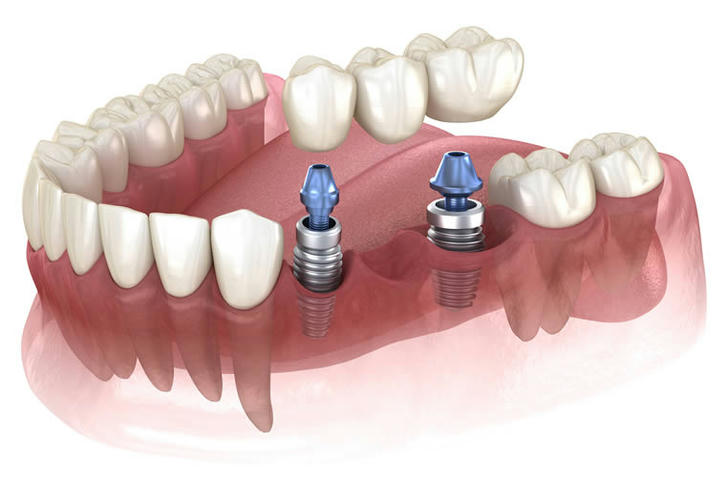How Much Do Dental Implants Cost?
I. Introduction
Understanding the cost of dental implants is essential for anyone considering this procedure. Dental implants are a significant financial commitment, and knowing the costs involved can help individuals budget and make informed decisions. The price of dental implants varies based on several factors, including the dentist’s experience, the location of the practice, and the complexity of the case. By being aware of these costs in advance, patients can prepare financially, explore payment options, and choose high-quality care without unexpected surprises.

II.Factors That Affect the Cost of Dental Implants
1. Dentist’s Experience and Reputation
•Experienced dentists with a solid reputation may charge more due to their skills and successful outcomes. Patients often feel more secure investing in a dentist known for high-quality results.
2. Location
•The cost of dental implants can vary significantly depending on geographic location. In major cities like New York or Los Angeles, prices tend to be higher due to increased living costs and demand for dental procedures.
3. Complexity of the Procedure
•More complicated cases, such as those requiring bone grafting or sinus lifts, typically cost more than straightforward implant placements. Additional procedures may be necessary to prepare the jawbone for implants.
4. Type of Implant
•Different types of implants (such as endosteal or subperiosteal) can have varying costs. Endosteal implants are more common and usually cost less than subperiosteal implants, which are used in specific cases.
5. Materials Used
•The quality of the materials used for the implant itself can impact the cost. Titanium implants are often more expensive but provide better integration with the bone compared to other materials.
6. Facility Fees
•This includes the costs associated with the dental practice where the surgery takes place. The reputation and quality of the facility can influence the overall price.
7. Anesthesia Fees
•The costs for anesthesia, which is often necessary for the procedure, are additional charges that should be factored into the total.
8. Post-Operative Care
•Follow-up appointments, medications, and any necessary supplies after the procedure can add to the overall cost, so patients should keep these in mind.
III. Average Cost of Dental Implants
1. National Average
As of 2024, the average cost of a single dental implant in the U.S. ranges from $3,000 to $6,000. The total cost can vary based on factors such as the type of implant, the dentist’s experience, and the complexity of the case.
Here’s a breakdown of typical costs:
•Single Dental Implant: $3,000 to $6,000
•Bone Grafting (if needed): $300 to $3,000
•Sinus Lift (if needed): $1,500 to $3,000
Patients should also consider additional costs like consultation fees and post-operative care when planning their budgets.
2. Cost by Region
New York: $4,000 - $7,000
•High demand and living costs in major cities contribute to increased prices.
Texas: $2,500 - $5,000
•Generally lower living costs make dental implants more affordable compared to larger cities.
California: $3,500 - $6,500
•Cities with high demand for dental procedures may have higher prices.
IV. User Examples

User Case 1: Anna’s Single Implant
Anna, a 32-year-old accountant, lost a tooth due to an accident and decided to get a dental implant. After consulting with a well-known oral surgeon, she was quoted $4,500 for the implant, including the crown. While she was initially concerned about the cost, Anna felt reassured by the surgeon’s experience. After the procedure, she said, “I’m so happy I went through with it! The investment was worth it for my confidence and smile.”
User Case 2: John’s Complex Case
John, a 55-year-old retired teacher, needed several dental implants due to years of neglect. He learned that he would need both bone grafting and implants, which totaled $12,000 for the entire process. Although it was a significant investment, John was pleased with the thorough explanation of the procedure and the quality of care he received. He shared, “It was daunting at first, but the results have changed my life! I can eat and smile without worry.”
User Case 3: Mary’s Unexpected Costs
Mary, a 45-year-old nurse, opted for a dental implant after losing a tooth. She initially paid $3,200 for the implant but later found out she needed a sinus lift, which added an extra $2,000 to her total costs. Despite the unexpected expense, Mary was grateful for the improved quality of her life. She remarked, “I wish I had known about the additional costs upfront, but now that it’s all done, I feel fantastic!”
V. Hidden Costs and Other Considerations
1. Revision Procedures
•If the initial implant does not heal properly or fails, patients may need additional surgery, which can significantly increase total costs.
2. Consultation Fees
•Some dentists charge for the initial consultation, and patients should factor this into their budget.
3. Pre-Operative Testing
•Medical tests may be required before the procedure, adding to the total cost.
4. Travel Expenses
•If patients travel to a different city or state for dental implants, they should include the costs of travel and accommodation.
VI. Tips for Managing Dental Implant Costs
1. Get Multiple Consultations
•Meeting with several dentists helps patients compare prices and find the best option for their needs.
2. Choose Certified Dentists
•It’s important to focus on the dentist’s qualifications rather than just the price. Opting for a less expensive option might lead to complications that could be costly to fix.
3. Know All Costs Upfront
•Ask for a detailed breakdown of all costs before agreeing to the procedure. This helps avoid unexpected expenses.
VII. Conclusion
Understanding the total cost of dental implants is key to making smart decisions. Patients should consider all expenses, including the dentist’s fee, facility and anesthesia costs, and any hidden charges after the procedure. By comparing prices and focusing on quality care, patients can avoid surprises and achieve the best results. Taking time to understand the costs and long-term benefits ensures a successful outcome and a worthwhile investment in dental health.
